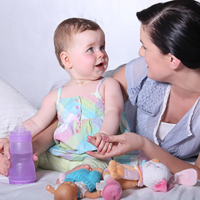Research digest
-

Can childcare attendance reduce externalising behaviour in children exposed to adversity?
Childcare attendance has been proposed as a public health initiative to help close the developmental gap between children from disadvantaged families and their wealthier peers.1,2 Now, Marie-Pier Larose and colleagues have investigated whether childcare attendance might modify the association between exposure to family adversity early in life and later externalising behaviour by buffering cognitive function.
Read more -

Emotional abuse during childhood is linked with differences in brain structure
Delia Gheorghe and colleagues at the University of Oxford have harnessed data from the UK Biobank to delineate the relationship between adverse experiences and brain structure. The researchers accessed brain imaging data together with retrospective reports of childhood adversity and adulthood partner abuse from more than 6,000 adults (mean age, 62.1 years).
Read more -

Mothers’ prenatal BMI is linked with foetal brain connectivity
New data suggest that a high maternal prenatal body mass index (BMI) is associated with differences in functional connectivity in the foetal brain that might confer a risk of mental health and cognitive problems in childhood.
Read more -

How does parenting style affect development in infants with a visual impairment?
Earlier this year, researchers from Great Ormond Street Hospital and the UCL Great Ormond Street Institute of Child Health in the UK published their latest findings from the OPTIMUM project: a national, longitudinal study investigating early development and interventions for young children with visual impairment.
Read more -

How much do we really know about ‘Theraplay’ for young children?
‘Theraplay’ is an intervention that aims to enhance attachment, self-esteem and trust in others for children with behavioural, emotional or developmental difficulties. The intervention, founded on attachment theory,1 harnesses natural and playful interactions between caregivers and children to develop healthy and positive relationships.
Read more -

Which disorders precede the development of mood disorders in young people?
Mood disorders such as bipolar disorder (BPD) and major depressive disorder (MDD) typically emerge in childhood or adolescence. Now, researchers in Switzerland, the USA and Canada have investigated whether certain other mental health disorders precede the onset of mood disorders
Read more -

Cognitive inflexibility contributes to both externalising and internalising difficulties in ASD
Children with autism spectrum disorder (ASD) commonly experience internalising and externalising symptoms, but the underlying cognitive mechanisms are unclear. In their latest study published in the Journal of Child Psychology and Psychiatry, Ann Ozsivadjian and colleagues examined the role of three cognitive factors that might contribute to these difficulties.
Read more -

Voice-hearing can be positive for some young people
Researchers in Manchester have described the diverse forms and functions of voices heard by young people. Sarah Parry and Filippo Varese collected demographic, contextual and qualitative data from 68 adolescents (13-18 years old) from around the world who had direct experience of voice-hearing.
Read more -

How effective is medication for ADHD symptoms in children with ASD?
Clinically significant attention-deficit/hyperactivity disorder (ADHD) symptoms are common and impairing in children with autism spectrum disorder (ASD).1 Moreover, ADHD is the most common co-occurring mental health diagnosis driving increased rates of medication use in children with ASD.
Read more -

Do brain function abnormalities lead to substance use, or vice versa?
New research has, for the first time, investigated the direction of links between brain function and substance use throughout adolescence. Jungmeen Kim-Spoon and colleagues studied 167 adolescents who were assessed annually for four years from 13-14 years old.
Read more